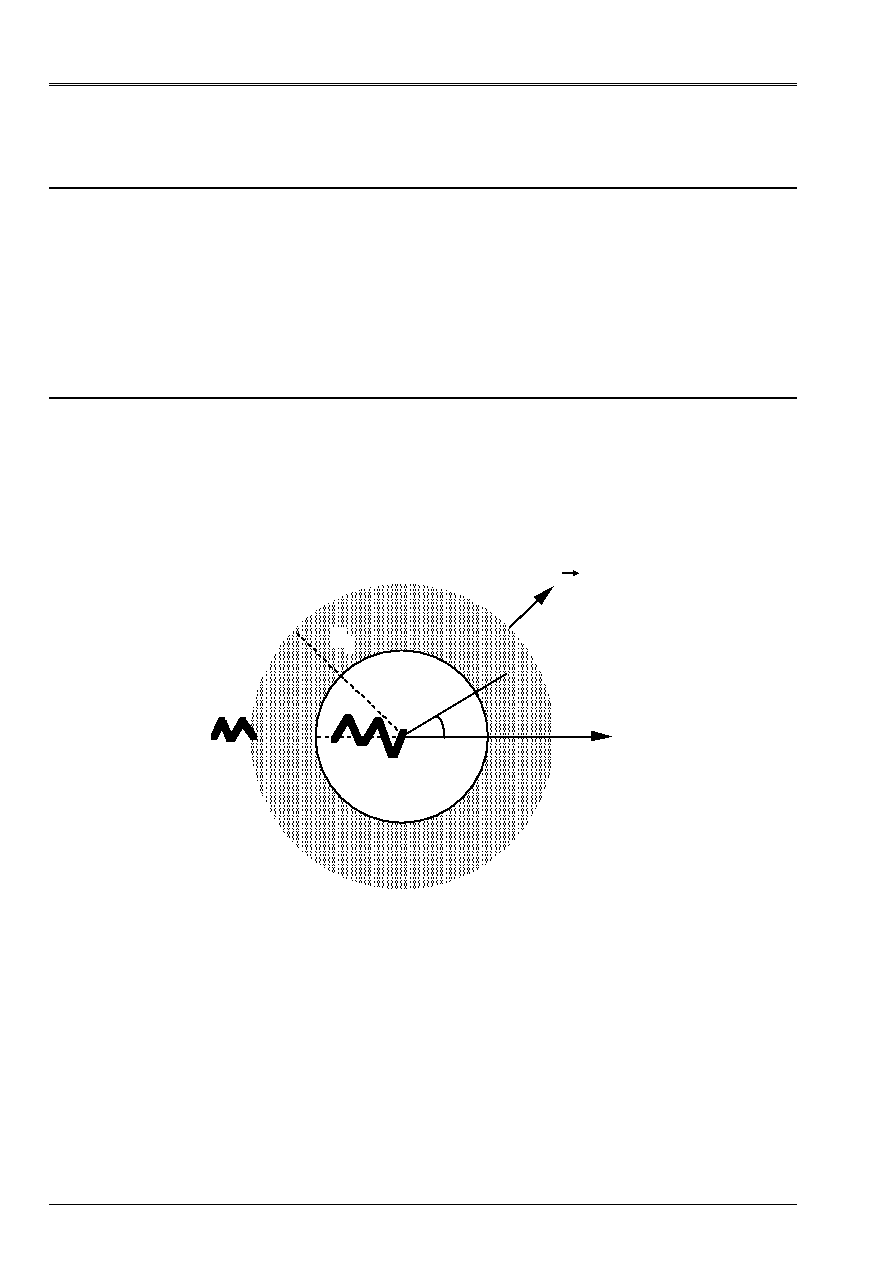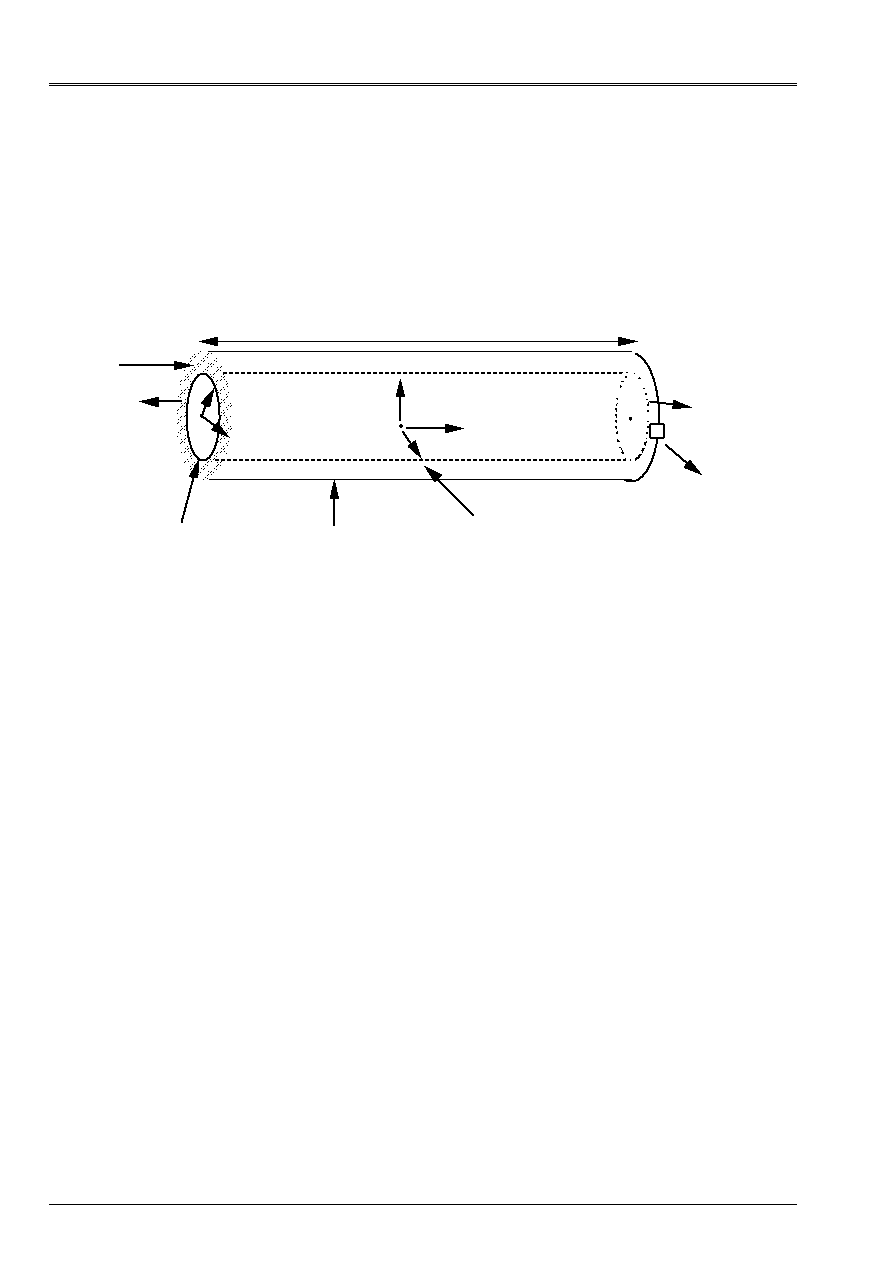
Code_Aster
®
Version
7.4
Titrate:
Macro-control
MACRO_MATR_AJOU
Date:
19/01/05
Author (S):
N.GREFFET, F. STIFKENS,
G. ROUSSEAU
Key
:
U4.66.11-D
Page
:
1/10
Instruction manual
U4.6- booklet: Elementary matrices/Vectors and assembly
HT-66/05/004/A
Organization (S):
EDF-R & D/AMA, EDF-DPN/UTO
Instruction manual
U4.6- booklet: Elementary matrices/Vectors and assembly
Document: U4.66.11
Macro-control
MACRO_MATR_AJOU
1 Goal
To calculate in a way more condensed than with CALC_MATR_AJOU of the matrices of mass,
of added damping or rigidity [R4.07.03]. The matrices are induced by a true fluid,
incompressible, at rest or in potential flow, on a structure in 2D, axisymmetric 2D or in
3D.
The terms of these matrices are calculated on the basis of modal structure in the vacuum.
One can also calculate by the launching of
CALC_FORC_AJOU
[U4.66.03] vectors of the forces
added induced by a seismic movement of drive also calculated on the modal basis
structure in the vacuum.
The interest of this macro-control is primarily to mask the calls to the operators of
linear thermics which calculates the hydrodynamic pressures caused by the vibration of
structure in the fluid. The user should from now on inform only the characteristics of sound
fluid field and clean modes in air of the structure, the operator giving the responsability themselves to calculate them
added matrices.
The possibilities of the control preserve those of the operator
CALC_MATR_AJOU
[U4.66.01].
An example of use of the macro-control
MACRO_MATR_AJOU
is presented in the case-test
FDLV106 [V8.01.106].

Code_Aster
®
Version
7.4
Titrate:
Macro-control
MACRO_MATR_AJOU
Date:
19/01/05
Author (S):
N.GREFFET, F. STIFKENS,
G. ROUSSEAU
Key
:
U4.66.11-D
Page
:
2/10
Instruction manual
U4.6- booklet: Elementary matrices/Vectors and assembly
HT-66/05/004/A
2 Syntax
MACRO_MATR_AJOU
(
MESH
=
netted
[mesh]
GROUP_MA_FLUIDE
=
fluid
[gr_ma]
GROUP_MA_INTERFACE
=
interf
[gr_ma]
MODELING =
/“3D”
/
“PLANE”
/
“AXIS”
FLUID
= _F (
RHO =
rho
[R]
ALL =
“YES”
GROUP_MA
=
grma
[group_ma]
NET
=
net
[mesh]
)
DDL_IMPO
= _F (
/PRES_FLUIDE = pfluide
[R]
/
PRES_SORTIE
=
psortie
[R]
/NODE = node
[node]
/
GROUP_NO
=
grno
[group_no]
)
FLOW
=
_F (
VNOR_1 = vnor1
[R]
VNOR_2 = vnor2
[R]
GROUP_MA_1
=
grma1
[group_ma]
GROUP_MA_2
=
grma2
[group_ma]
POTENTIAL = phi [evol_ther]
)
/
MODE_MECA
=
modes
[mode_meca]
/
DEPL_IMPO
=
chamno
[cham_no_DEPL_R]
/
MODELE_GENE
=
modgen
[modele_gene]
NUME_DDL_GENE
=
numgen
[nume_ddl_gene]
DIST_REFE
=
/
outdistance
[R]
/
1.0
D-2 [DEFECT]
I
MATR_MASS_AJOU
=
massaj
[matr_asse_gene_R]
I
MATR_RIGI_AJOU
=
rigiaj
[matr_asse_gene_R]
I
MATR_AMOR_AJOU
=
amoraj
[matr_asse_gene_R]
/MONO_APPUI = “YES”
/
MODE_STAT
=
mode
[mode_stat_depl]
FORC_AJOU = _F (
NODE
=
No [l_noeud]
GROUP_NO
=
grno
[l_group_no]
DIRECTION
=
direction [l_R]
VECTOR
= vector
[vect_asse_gene]
)
SOLVEUR = to see [U4.50.01]
INFORMATION
=
/
1
[DEFECT]
/2
NOEUD_DOUBLE
=/“YES”
/
“NOT”
[DEFECT]
AVEC_MODE_STAT=
/
“YES”
[DEFECT]
/
“NOT”
);

Code_Aster
®
Version
7.4
Titrate:
Macro-control
MACRO_MATR_AJOU
Date:
19/01/05
Author (S):
N.GREFFET, F. STIFKENS,
G. ROUSSEAU
Key
:
U4.66.11-D
Page
:
3/10
Instruction manual
U4.6- booklet: Elementary matrices/Vectors and assembly
HT-66/05/004/A
3 Operands
3.1 Operand
MESH
Name of the mesh containing the fluid field and the fluid interface/structure. This mesh can too
to include the structure.
3.2 Operand
GROUP_MA_FLUIDE
GROUP_MA_FLUIDE = fluid
Groups of meshs (plane meshs in 2D and axisymmetric 2D, voluminal meshs in 3D)
representing the fluid field acting on the studied structure.
3.3 Operand
GROUP_MA_INTERFACE
GROUP_MA_INTERFACE = interf
Groups of meshs representing the interface enters the fluid and the structure (plane meshs or
telegraphic). It should be stressed that this group of meshs can be one of those used to modelize
surface structure, in particular if the aforementioned is modelized by elements of hull. It is not
not always necessary to create a group of meshs of interface specific with meshs to
whole share.
3.4 Operand
MODELING
Type of modeling to be assigned to the fluid field and the fluid interface/structure. Currently, them
modelings '
PLAN
“(fluid field 2D),”
3D
“(voluminal fluid field) and”
AXIS
'(fluid field
axisymmetric) are only authorized.
3.5 Word
key
FLUID
Key word factor where one affects the fluid material characteristics. If density of the fluid
vary on the fluid field, it is necessary to specify these various densities by several
occurrences of the key word factor
FLUID
.
3.5.1 Operand
RHO
RHO = rho
Value of the density of the fluid to be affected on the below definite topological entities.
3.5.2 Operands
ALL
/
GROUP_MA
/
NET
Meshs, group of meshs or totality of the fluid field where one affects the density
RHO
.
3.6 Word
key
DDL_IMPO
Key word factor by which one specifies the boundary conditions of the fluid (of Dirichlet type).
3.6.1 Operands
NODE
/
GROUP_NO
Nodes or groups of nodes where one imposes the boundary conditions on the fluid field.

Code_Aster
®
Version
7.4
Titrate:
Macro-control
MACRO_MATR_AJOU
Date:
19/01/05
Author (S):
N.GREFFET, F. STIFKENS,
G. ROUSSEAU
Key
:
U4.66.11-D
Page
:
4/10
Instruction manual
U4.6- booklet: Elementary matrices/Vectors and assembly
HT-66/05/004/A
3.6.2 Operand
PRES_FLUIDE
Key word under which one specifies the value that one imposes on the hydrodynamic pressure (i.e.
disturbance of pressure created by the vibration of the structure) on the given topological entity
above. This key word must appear at least once because it makes it possible to calculate the fields of
pressure non stationary generators of the added mechanical magnitudes.
3.6.3 Operand
PRES_SORTIE
Pressure of exit to be imposed on a permanent flow. Key word to employ (in an occurrence
different from the key word factor
DDL_IMPO
where one used
PRES_FLUIDE
) to specify the conditions
with the limits on the permanent sizes to calculate (like the potential fluid speeds
permanent characterizing a permanent flow disturbed by the vibrations). This key word is not with
to use that if one wants to calculate the matrices of added damping and rigidity which require it
calculation of a presumedly potential permanent flow.
3.7 Word
key
FLOW
This key word factor makes it possible to determine the boundary conditions of the Neumann type when one wants
to calculate a presumedly potential permanent flow, to be able to calculate damping and rigidity
added.
3.7.1 Operands
GROUP_MA_1
/
GROUP_MA_2
Names of the groups of meshs respectively of input and exit of the fluid field where one imposes
conditions normal speed of input or exit of the fluid.
3.7.2 Operands
VNOR_1
/
VNOR_2
Actual values normal speeds of the fluid respectively at the entry and the exit of the field
fluid.
3.7.3 Operand
POTENTIAL
Name given by the user to the potential permanent fluid speeds if he wants possibly it
post-to treat.
3.8 Operands
MODE_MECA
/
DEPL_IMPO
/
MODELE_GENE
/MODE_MECA = modes
Dynamic modes calculated on the model structure. If there are several structures not
related immersed in the same fluid, for which one wants to determine the matrices
added including/understanding the terms of coupling by the fluid, the model structure which one defines
gather the totality of the immersed structures. The modes used by the operator are them
modes calculated for the total structure.
/DEPL_IMPO = chamno
Fields with the nodes of displacements affected on groups of nodes defining
the fluid interface/structure. By affecting such a field of displacement on (S) the group (S) of
nodes of interface thanks to the operator
AFFE_CHAM_NO
[U4.44.11], one can for example
to easily simulate modes of rigid body of the structures. This operand is to be used if
one wants to estimate the terms of the added matrices and coupling for a plane geometry
without making as a preliminary modal calculation of the structure in the vacuum, and which one wants
to affect these terms in discrete elements (modeling
DIS_T
). The operand
INFORMATION
must
imperatively to be active to visualize the calculated terms.

Code_Aster
®
Version
7.4
Titrate:
Macro-control
MACRO_MATR_AJOU
Date:
19/01/05
Author (S):
N.GREFFET, F. STIFKENS,
G. ROUSSEAU
Key
:
U4.66.11-D
Page
:
5/10
Instruction manual
U4.6- booklet: Elementary matrices/Vectors and assembly
HT-66/05/004/A
Caution:
The use of this operand excludes that from the operand
NUME_DDL_GENE
. One cannot
thus not to make modal, transitory calculation or harmonic by using the operand
CHAM_NO
.
Indeed, to make calculation of modes out of water, it is necessary to have a matrix of mass
generalized and a matrix of rigidity generalized of the structure. This supposes to have
fact a modal calculation on the structure in the vacuum (what one wants precisely to avoid).
This operand is used ultimately only to evaluate the matrix of mass, of
rigidity and of damping added, and to use them to couple structures of the type
beam by discrete elements of mass, for example.
/MODELE_GENE = modgen
Generalized model built by the operator
DEFI_MODELE_GENE
[U4.65.02]. This key word is with
to use when one makes a calculation by dynamic under-structuring, and that one wants to calculate
stamp of added mass coupling the whole of the substructures. In this case, under
structures can be in different files of mesh, these files being able to be them
same distinct from the fluid file of mesh. The substructures which present one
repetitivity within the fluid are to be netted only only once, but one will take care with
level of the fluid mesh to net all the interfaces fluid/structure. Moreover, it is necessary to take care
so that the nodes of fluid interface coincide as well as possible with the nodes of interface of
structure, in order to be able to recopy, on the basis of geometrical criterion of proximity, them
values of the fields of displacement of structure on the nodes of fluid interface (see
operand
DIST_REFE
).
3.9 Operands
MATR_MASS_AJOU
/
MATR_AMOR_AJOU
/
MATR_RIGI_AJOU
These key words specify the name user of the matrices of mass, rigidity or added damping (E)
that one wants to calculate. One needs at least one of these key words to operate calculation. 3 key words
can be used simultaneously, but in the case of the use of
MATR_AMOR_AJOU
or
MATR_RIGI_AJOU,
should be informed the key words
FLOW
and
DDL_IMPO
with
PRES_SORTIE
.
3.10 Operand
DIST_REFE
Outdistance reference to be informed when one makes a calculation of mass added on a model
generalized. This distance is a geometrical absolute criterion of proximity intended to recopy
values of structural displacements in a fluid field, in order to solve the equation of Laplace there
non stationary field of pressure. By defect, it is equal to 10
2
.

Code_Aster
®
Version
7.4
Titrate:
Macro-control
MACRO_MATR_AJOU
Date:
19/01/05
Author (S):
N.GREFFET, F. STIFKENS,
G. ROUSSEAU
Key
:
U4.66.11-D
Page
:
6/10
Instruction manual
U4.6- booklet: Elementary matrices/Vectors and assembly
HT-66/05/004/A
3.11 Operand
NOEUD_DOUBLE
NOEUD_DOUBLE = “YES”
This operand is to be used when one makes a calculation of mass added starting from a model
generalized which includes/understands a substructure with a grid by a telegraphic or surface mesh (i.e without
thickness like beam or hull) and surrounded by two fluids. It is necessary in this case for the level of
mesh to duplicate the nodes of the fluid interfaces of those of the structure, in order to be able
to calculate the hydrodynamic jump of pressure on both sides of the structure (cf appears
below).
X X X xxxx
X
X
X
X
X
X
X
X
X
X
X
X
xx
xx
X X
fluid 1
Structure with a grid
(without thickness)
fluid 2
Duplicated nodes
(nodes having the same ones
co-ordinates but not it
even name)
3.12 Operand
AVEC_MODE_STAT
AVEC_MODE_STAT = “NOT”
This operand makes it possible to disconnect the calculation of the terms of mass added on the modes
statics contained in the modal base of the substructures in the case of a calculation with one
generalized model (cf [§3.8]).
3.13 Operand
NUME_DDL_GENE
NUME_DDL_GENE = numgen
Generalized classification based on the mechanical modes of the total structure. The presence
of this operand allows to calculate a matrix of added mass of type
matr_asse_gene_R
.
It must be necessarily present if one wants to make modal, harmonic calculation thereafter or
transient.
3.14 Description of the seismic movement of drive
3.14.1 Operand
MONO_APPUI
/
MONO_APPUI = “YES”
The structure is uniformly excited in all the supports (movement of drive of body
solid).

Code_Aster
®
Version
7.4
Titrate:
Macro-control
MACRO_MATR_AJOU
Date:
19/01/05
Author (S):
N.GREFFET, F. STIFKENS,
G. ROUSSEAU
Key
:
U4.66.11-D
Page
:
7/10
Instruction manual
U4.6- booklet: Elementary matrices/Vectors and assembly
HT-66/05/004/A
3.14.2 Excitation multi supports: operand
MODE_STAT
In this case, the accelerations undergone by the whole of the points of anchoring of the studied structure
are not inevitably identical and in phase.
/
MODE_STAT = mode
Static modes of the structure: concept of the type
mode_stat_depl
product by
the operator
MODE_STATIQUE
[U4.52.14] with option DDL_IMPO. They correspond to the 3
or 6
*
nb_supports static modes where nb_supports is the number of accélérogrammes
different undergone by the structure.
Note:
If the structure is requested only by translations, there are then 3 nb_supports
static modes.
3.15 Added forces due to the seismic movement of drive:
key word
FORC_AJOU
3.15.1 Operands
NODE
/
GROUP_NO
/
NODE
= noeu
/
GROUP_NO = g_noeu
List nodes (
noeu
) or groups of nodes (
g_noeu
) of the structure subjected to the excitation
seismic: these nodes support them
ddl
supports of the structure to which they are applied
imposed movements.
3.15.2 Operand
DIRECTION
DIRECTION = (d1, d2, d3, r1, r2, r3)
Components of a vector giving the direction of the seism of drive in the total reference mark.
It is a list of three realities if the imposed accélérogrammes are only translations. If
one also imposes accelerations of rotations, one awaits a list of six realities (valid for
modelings with discrete elements).
3.15.3 Operand
VECTOR
VECTOR
= vector
[vect_asse_gene]
Name of the vector forces added created by the launching of the operator
CALC_FORC_AJOU
[U4.66.03].
It there as many vectors created of occurrences of the key word
FORC_AJOU
.
3.16 Word
key
SOLVEUR
Key word factor specifying the technique of resolution of system linear appearing here in calculation
non stationary fields of pressure. See [U4.50.01].
3.17 Operand
INFORMATION
INFORMATION
=
Indicate the level of impression of the results of the operator,
1:
no impression,
2:
impression of the higher triangular part of the matrices of added mass,
added damping or rigidity.
Presentation in column.

Code_Aster
®
Version
7.4
Titrate:
Macro-control
MACRO_MATR_AJOU
Date:
19/01/05
Author (S):
N.GREFFET, F. STIFKENS,
G. ROUSSEAU
Key
:
U4.66.11-D
Page
:
8/10
Instruction manual
U4.6- booklet: Elementary matrices/Vectors and assembly
HT-66/05/004/A
4 Phase
of execution
It is checked that the storage of the added matrices is done on a full profile.
It is checked that the coefficients of car masses added (diagonal terms of the matrix) are well all
positive. In the contrary case, a message of alarm is transmitted so that the user checks the orientation
normals.
In the case of a calculation of mass added on a generalized model, one informs the user on
recopies of fields of structural displacements in the fluid (a number of recopied values) and one
indicate how to change the distance from reference (
DIST_REFE
).
5 Example
5.1 Example 1: Calculation of the matrix of mass added of a structure
composed of two concentric cylinders separated by a fluid
incompressible
The cylinders are supported each one by springs. The matrix of added mass is calculated for
the first two modes of the structure, namely the modes of rigid body of each cylinder
in direction OX (cf diagram).
R
X
R
2
(
)
2
(
)
1
R
1
N
M
R
k1
k2
m1
m2
1) Assignment of the total model structure (including/understanding the two cylinders and their springs of
self-supporting quality).
struct = AFFE_MODELE (MESH = MAYA,
AFFE = _F (GROUP_MA = “cylinder”,
MODELING = “D_PLAN”,
PHENOMENON = “MECHANICAL”),
_F (GROUP_MA = “cylext”,
MODELING = “D_PLAN”,
PHENOMENON = “MECHANICAL”),
_F (GROUP_MA = “arises”,
MODELING = “DIS_T',
PHENOMENON = “MECHANICAL”),
_F (GROUP_MA = “ressorex”,
MODELING = “DIS_T',
PHENOMENON = “MECHANICAL”),)

Code_Aster
®
Version
7.4
Titrate:
Macro-control
MACRO_MATR_AJOU
Date:
19/01/05
Author (S):
N.GREFFET, F. STIFKENS,
G. ROUSSEAU
Key
:
U4.66.11-D
Page
:
9/10
Instruction manual
U4.6- booklet: Elementary matrices/Vectors and assembly
HT-66/05/004/A
2) Calculation of the clean modes of the structure in the vacuum
modes = MODE_ITER_SIMULT (MATR_A = matasks,
MATR_B = matasms,
CALC_FREQ = _F (OPTION = “PLUS_PETITE”,
NMAX_FREQ = 2))
3) Generalized classification based on the calculated mechanical modes
numgen = NUME_DDL_GENE (
MODE_MECA = modes,
STORAGE = “FULL”)
4) Calculation of the matrix of added mass of type
matr_asse_gene_r
(operand
NUME_DDL_GENE
present). So one can then calculate the clean modes of the “wet” structure
MACRO_MATR_AJOU (MESH = Maya,
GROUP_MA_FLUIDE = '
grfluide',
MODELE_INTERFACE =
grinter,
MODELING = “PLANE”,
FLUID = _F (RHO = rho,
GROUP_MA = “grtotal”),
DDL_IMPO = _F (GROUP_NO = “noflui”,
PRES_FLUIDE = 0. ),
MATR_MASS_AJOU = massaj,
MODE_MECA = modes,
NUME_DDL_GENE = numgen,
INFORMATION =1)
5) Calculation of the matrices of mass and stiffness generalized on generalized classification based
on the calculated mechanical modes
numgen
. These matrices are of type
[matr_asse_gene_r]
MACRO_PROJ_BASE (BASE = modes,
_F (MATRIX = CO (“matasms”),
MATR_ASSE = mgene),
_F (MATRIX = CO (“matasks”),
MATR_ASSE = riggen))
6) Calculation of the matrix of total mass of the structure (matrix of more generalized mass matrix
of added mass)
mastot = COMB_MATR_ASSE (COMB_R = _F (MATR_ASSE = mgene,
COEF_R = 1. ),
_F (MATR_ASSE =
matraj,
COEF_R = 1. ))
7) Calculation of the modes of the immersed structure.
modhumi = MODE_ITER_SIMULT (MATR_A =riggen,
MATR_B:
mastot,
CALC_FREQ = _F (OPTION = “PLUS_PETITE”,
NMAX_FREQ = 2))
8) Restitution of the modes “wet” on physical basis.
mode_mou = REST_BASE_PHYS (RESU_GENE = modhumi,
MODE_MECA = modes)

Code_Aster
®
Version
7.4
Titrate:
Macro-control
MACRO_MATR_AJOU
Date:
19/01/05
Author (S):
N.GREFFET, F. STIFKENS,
G. ROUSSEAU
Key
:
U4.66.11-D
Page
:
10/10
Instruction manual
U4.6- booklet: Elementary matrices/Vectors and assembly
HT-66/05/004/A
5.2
Example 2: roll subjected to an annular flow
This case (cf case-test FDLV106 [V8.01.106]) implements the calculation of mass, damping added,
and of rigidity added on a cylindrical structure subjected to an annular flow which one supposes
potential. One calculates mass and damping initially added by the flow on
structure for various speeds upstream (4 m/s, 4.24 m/s and 6 m/s), this on a model 3D for
fluid and hull for the structure. The structure has a displacement of rotation around a pivot located at
the downstream end of the cylinder compared to the flow.
Z
y
X
V
0
input
fluid
L
roll fixed intern
external cylinder
mobile in rotation around the pivot C
X
C
R
I
R
E
N
exit
N
not
swivelling
1) After having modelized the cylindrical structure and having calculated its modes in air, the control
MACRO_MATR_AJOU
allows to calculate the mass, the rigidity and damping added by the fluid in
flow on this structure:
MACRO_MATR_AJOU (MESH = Maya,
GROUP_MA_FLUIDE = '
grfluide',
MODELE_INTERFACE = gr.
inter,
MODELING = “3D”,
FLUID = _F (RHO = rho,
GROUP_MA = “grtotal”),
DDL_IMPO = (_F (GROUP_NO = “noflui”,
PRES_FLUIDE = 0. ),
_F (GROUP_NO = “nosortie”,
PRES_SORTIE = 0. )),
FLOW = _F (GROUP_MA_1 = “entered”,
GROUP_MA_2 = “left”,
VNOR_1 = 4. ,
VNOR_2 = - 4. ),
MATR_MASS_AJOU = “massaj”,
MATR_AMOR_AJOU = “amoraj”,
MATR_RIGI_AJOU = “rigiaj”,
MODE_MECA: = modes,
NUME_DDL_GENE = numgen,
INFORMATION = 1)









